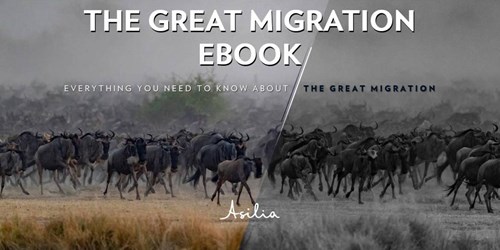The best time to see the Great Migration each month
There is no single time of year to see the Great Migration since it is an eternal annual cycle from place to place, year in and year out. However, depending on either the aspect of the Great Migration you want to witness (such as river crossings), or the time of year that you prefer to travel, your safari can be tailored to give you the best chance of seeing what you desire. The Great Migration can be summarised in this way as having these four seasons.
Alternatively, you can learn more about when to travel via through this month-by-month breakdown of the Great Migration.
Whether the great herds are calving in the south or on the move north in search of greener pastures – and then back again – there is a huge variety of astounding scenes unfolding before you.
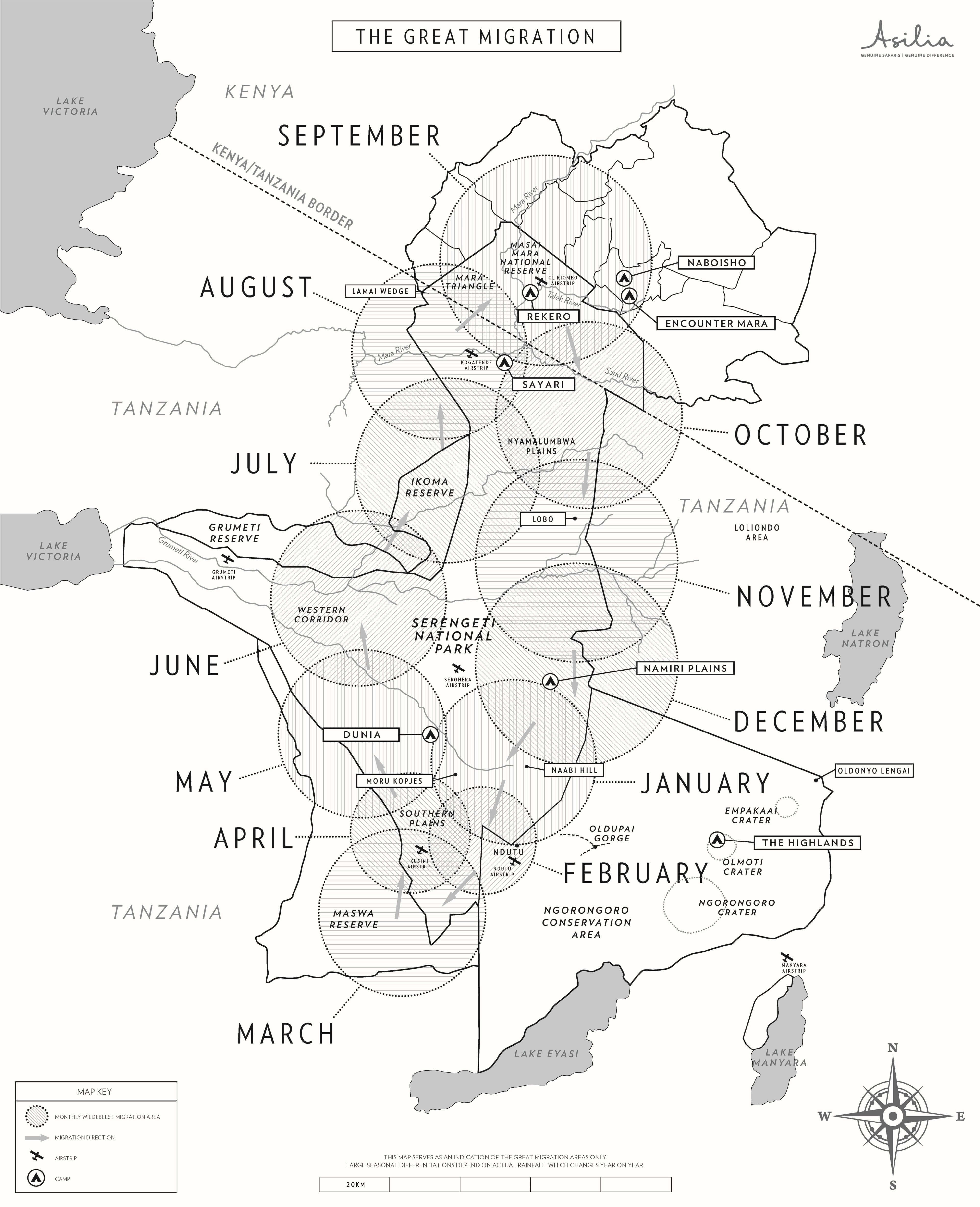
The Great Migration seasons
You can see the Great Migration at any time of year. It is possible to look at historic migration patterns to predict where the herds will be at a particular time, but ultimately these are wild animals and the annual rainfall they rely on to stimulate grass growth is becoming more unpredictable. Asilia's camp lie all along the migration route, proving our guests with the best opportunity to see the migration up close when on safari.
Learn more below about the different season of the Great Migration:
January to March: calving season | April to mid-June: the trek north | Mid-June to November: river crossings | December: calving begins
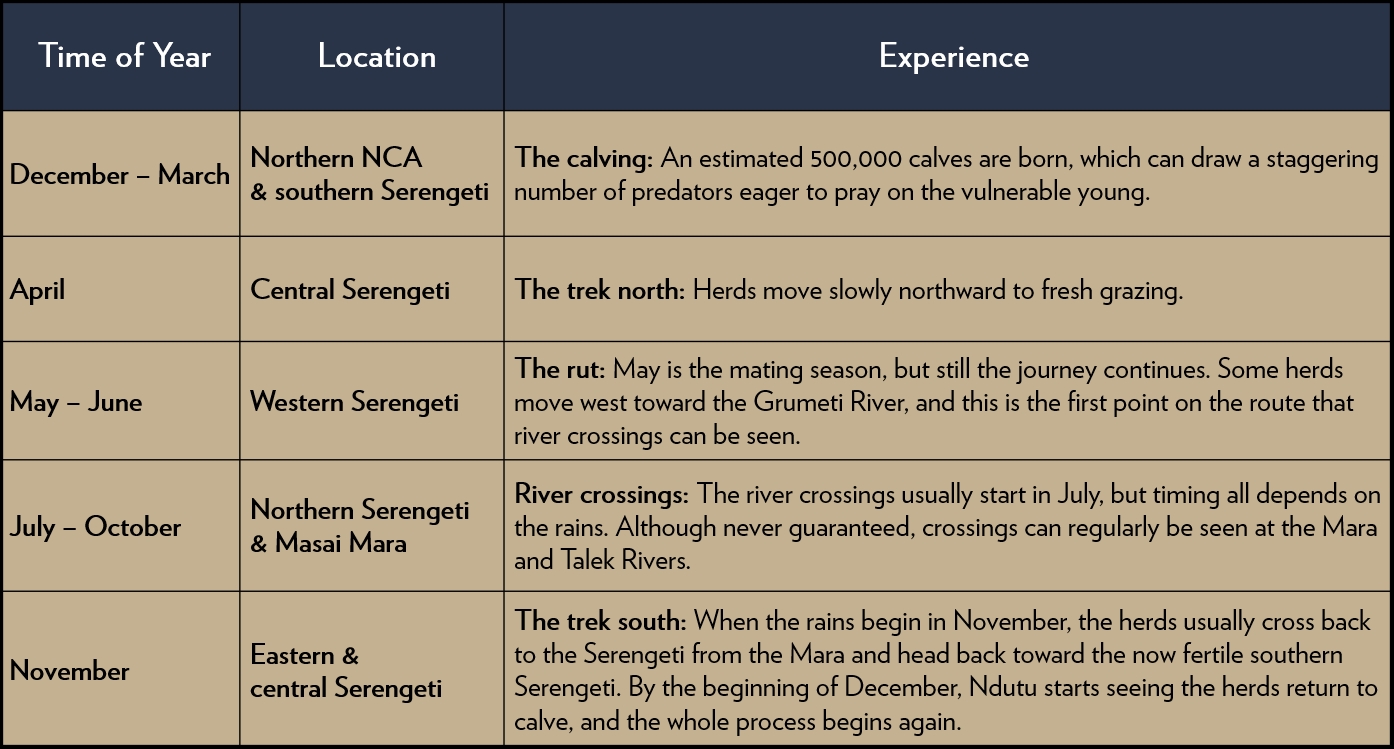
January - March: The Calving Season Continues
The herds congregate on the short grass plains of the southern Serengeti and westernmost regions of the Ngorongoro Conservation Area. An estimated 500 000 calves are born during a two- to three-week window in February. This mass calving draws a staggering number of predators eager to prey on the vulnerable newborns.
- Dec / Jan – The Southern Plains are lush with fresh, sweet grasses for the wildebeest to graze on. The areas around Ndutu and the northern Ngorongoro Conservation Area are where the herds will spend some time enjoying the abundant grazing in preparation for the birth of the new calves.
- February – Between late January and mid-March over 80% of fertile female wildebeest drop their calves within a few weeks of each other. Over 500,000 tiny wildebeest dot the plains and the predators swoop in to feast on the easy prey.
- March – At this time, the wildebeest are still occupying the southern area of the Park but preparing to move north as the plains dry out.
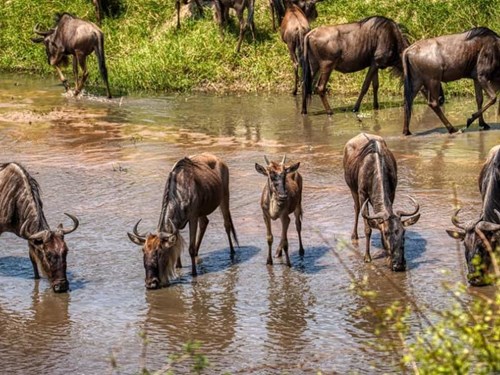
April to mid-June: Season of the Trek North and The Rut
As the rains come to an end and the ground dries, the herds start making their way north into the central Serengeti where the grass is still fresh and they can graze and tend their young. Moving slowly, they graze as they go, making the most of the fresh grass. Mating season begins and the male wildebeest do fierce battle for a mate. Throughout the rut, the journey continues as some herds head west into the Western Corridor and cross the Grumeti River.
- April – The wildebeest begin their long trek north, through the central area of the park. The herds move at leisure, grazing as they go along.
- May – The impressive columns of wildebeest up to several kilometers long can be seen flooding the Moru Kopjes in the central area of the park.
- First half of June – Large concentrations of wildebeest can be seen on the southern banks of the Grumeti River in the Western Serengeti, ready to face their first challenge of crossing the crocodile infested river.
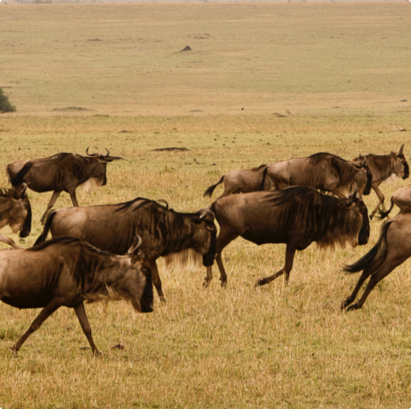
Mid-June to November: Great Migration River Crossing Season
The herds head towards the north of the Serengeti. The river crossings, considered by some to be the most exciting events of the Great Migration, usually start in July, but timing all depends on the rains.
The herds can be found in the Northern Serengeti as well as in Kenya’s Masai Mara. Daily river crossings can be seen at the Mara and Talek rivers – both often central to highly dramatic scenes.
Later, the herds usually cross back to the Serengeti from the Mara and head towards the now fertile southern Serengeti. The herds travel fast and cover long distances in a single day. By the beginning of December, Ndutu starts seeing the herds return to calve, and the whole process begins again.
- July – The migration gathers momentum and huge herds of wildebeest can be seen spread out across the Western corridor as they continue the journey north. The first herds will begin to arrive in the North in early July.
- August – As the dry season approaches, the wildebeest face the second challenge of their trek: the Great Mara River. Many will perish but the thousands of calves that are born more than make up the numbers.
- September – The herds are mostly concentrated in the Maasai Mara in Kenya, the northernmost range of the trek, but many still remain in the Serengeti.
- October – The wildebeest face the swollen waters of the Mara River for the second time as they cross on their journey back south.
- November – The short rains arrive, propelling the wildebeest down south to the rejuvenated grasses of the Serengeti.
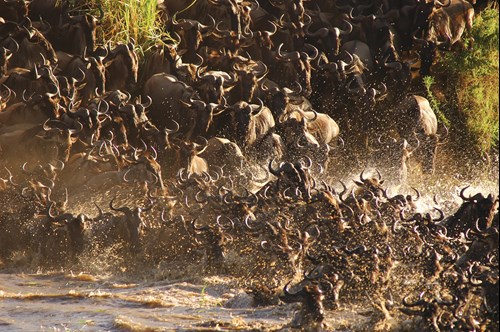
December: Calving Season Begins
The herds congregate on the short grass plains of the southern Serengeti and northernmost regions of the Ngorongoro Conservation Area. An estimated 500 000 calves are born during a two- to three-week window in February. This mass calving draws a staggering number of predators eager to prey on the vulnerable newborns.
- Dec / Jan – The Southern Plains are lush with fresh, sweet grasses for the wildebeest to graze on. The areas around Ndutu and the northern Ngorongoro Conservation Area are where the herds will spend some time enjoying the abundant grazing in preparation for the birth of the new calves.
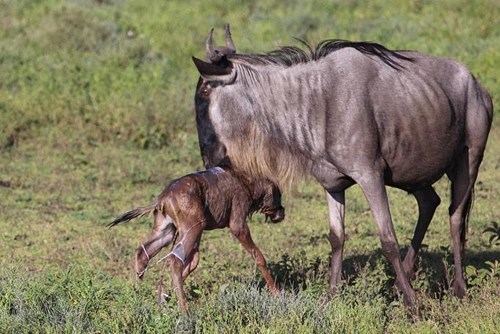
The Great Migration from January to December
Learn more below about historical patterns that predict where the Great Migration is each month:
January | February | March | April | May | June | July | August | September | October | November | December
January
Wildebeest begin to gather in the southern plains, from Moru south to Naabi, Kusini and Ndutu. The short grasses here are rich in phosphorus and magnesium due to the volcanic ash of the calcrete layer just below the plains’ shallow soil. Pack your waterproof items, as there may be intense thunderstorms throughout the region. You may be rewarded with a few early calving sightings.
February
February is peak calving month, and there’s nothing quite like the sight of hundreds of thousands of newborn wildebeest taking their first steps amid stationary herds. You can spot them from the Ndutu and Kusini plains, all the way toward the Ngorongoro Highlands. This is the driest month of the rainy season, although sparse showers still occur.
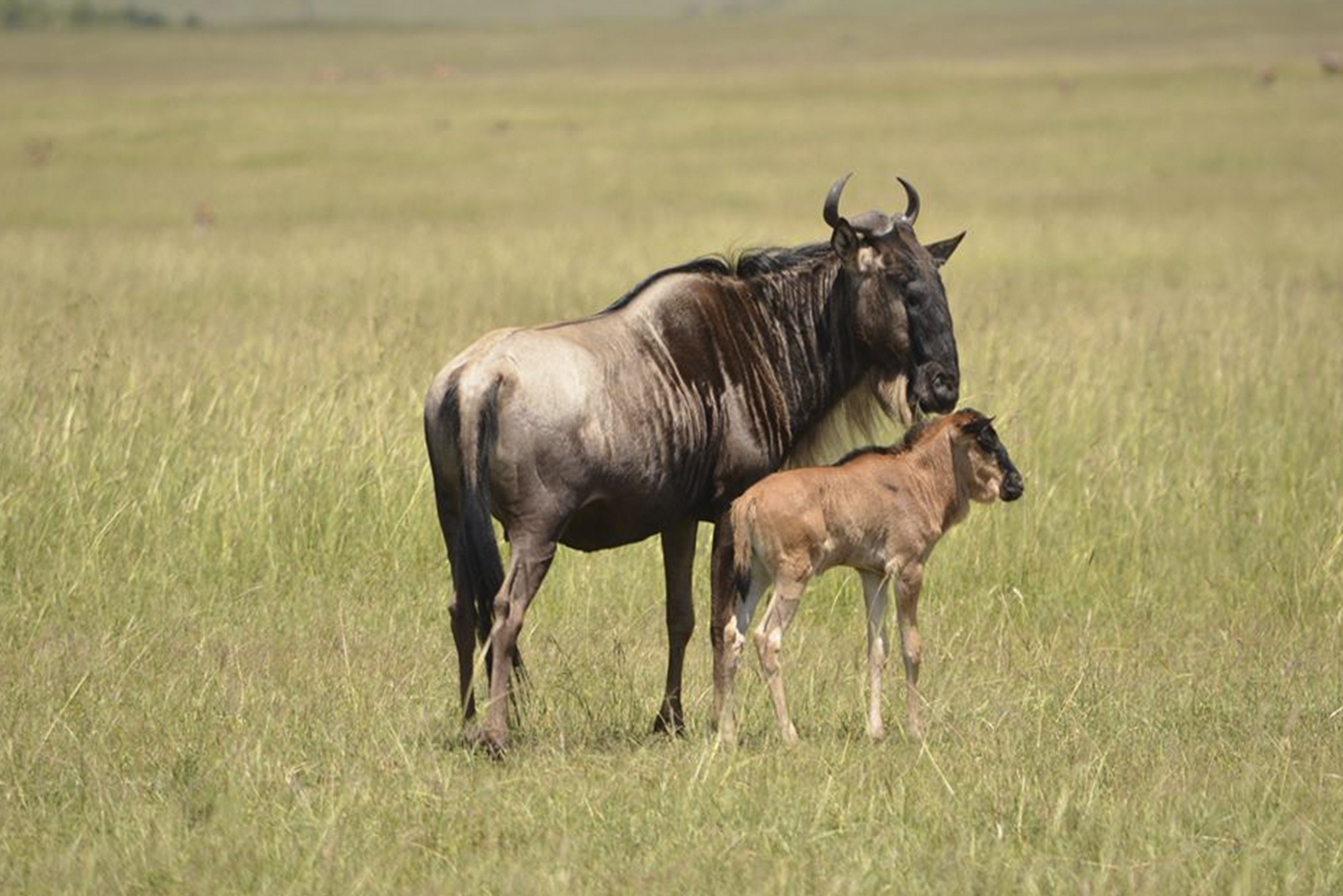
March
Toward the end of the calving season, the herds are mostly still stationary in the Ndutu-Kusini area, with some animals permeating even further south into Maswa and east in the direction of Namiri Plains (prime predator country, so keep your camera close). The last of the wildebeest calves are born amid heavy, regional thunderstorms.
April
This is the last month you’ll be able to witness the massive herds (plus calves) taking it slow on the plains in the Naabi and Kusini areas. They’ll be making the most of what remains of the nutritious Digitaria, Sporobolus, Andropogon and Cynodon grasses before beginning their long and often perilous journey north.
May
Starting this month, the wildebeest will continually be on the move, heading north through the Moru Kopjes and toward the Western Corridor. Dramatic thunderstorms (good to photograph) persist, providing water to the medium-to-tall Pennisetum and Tussocky Themeda grasses that the herds will now be grazing on. There is slightly less nutrition in the vegetation, prompting the animals’ continued movement northward.
June
The Great Migration is in full swing, travelling swiftly up through the Western Corridor and Grumeti Reserve. It’s peak rutting time, as well as the beginning of the dry season, though there are still localised showers in the north. From now on, the animals’ nutrition depends largely on the growth stage of the Digitaria, Pennisetum, Eustachys and Themeda grasses anchored in nutrient-rich clay amid the woodlands.
July
For wildebeest, the grass really is greener on the other side — of the Mara and Sand rivers, that is. Crossings are the stuff nature documentaries are made of, and a stay at Sayari means you’re perfectly positioned to catch the action. The head of the herd will have reached the Kogatende area in the northern Serengeti, ready to cross the Mara and Sand rivers, complete with hungry crocodiles lurking in the water.
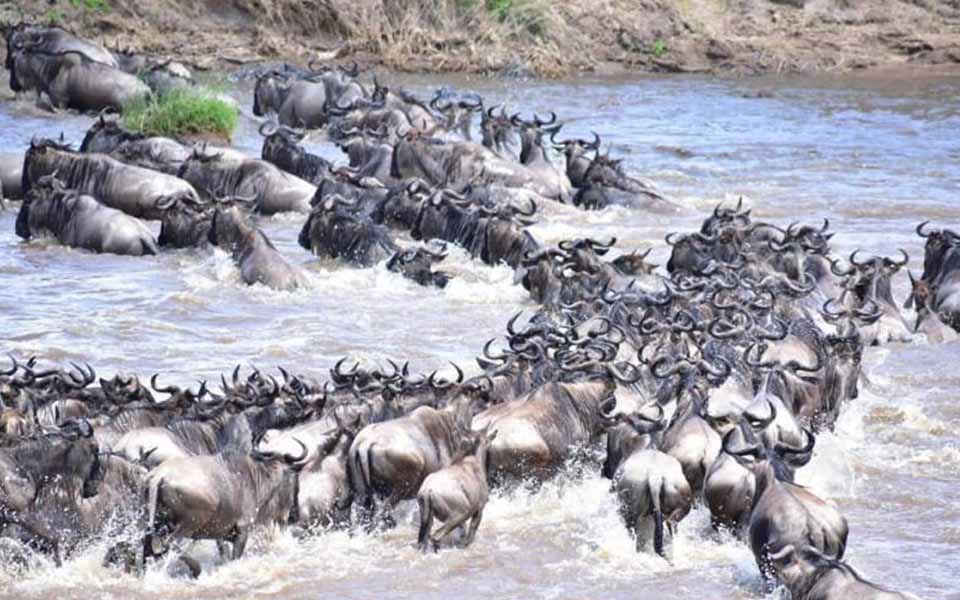
August
For the most part, herds will cross south to north, drawn by the more nutritious grazing on the northern side thanks to earlier showers. However, some crossings also occur in the opposite direction. For spectacular sightings of the bulk of the wildebeest herds, interspersed with dazzles of zebra and herds of antelope, head to the Lamai Wedge and Nyamalumbwa Plains.
September
River traffic flows in both directions between Kenya and Tanzania in September, though a southerly direction will prevail by the end of the month. This treacherous traverse is one of nature’s greatest and most tragic spectacles, and tens of thousands of animals will die in the attempt. The rains remain absent in the south, with sparse showers still occurring in the north.
October
The tail end of the herd crosses the river from Kenya down into Tanzania, as thunderstorms begin in the north. Meanwhile, the bulk of the animals are moving back down into the Lobo Valley region and Grumeti Reserve, tracing their epic annual circle back south toward their calving grounds.
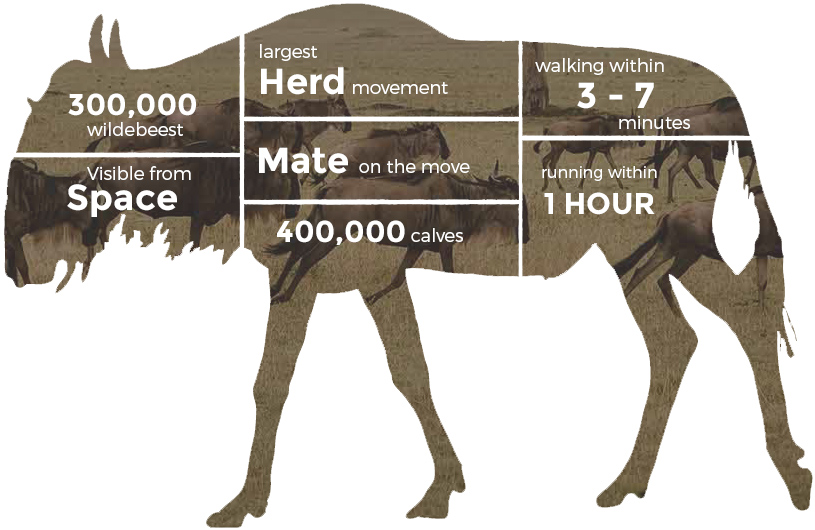
November
Marching ever onward, the herds have largely left the north and are passing through the Lobo region toward the central Serengeti. Rain is still scarce here, and the nutrition inherent in the grasslands is less than ideal. Interestingly, the reason the wildebeest can still share grazing land with zebra is because the two animals consume different parts of individual blades of grass.
December
The Great Migration is now dispersed across the central Serengeti, from as far north as Lobo, to the southern reaches of Ndutu. The rains catch up at last with the still-moving herds, and intense thunderstorms and localised showers are experienced across the region. The animals have returned to the more nutritious Pennisetum, Sporobolus, Andropogon, Cynodon and Themeda grasses, ready to calve in the south and begin the great cycle all over again.
More about the Great Wildebeest Migration
 Blog
Blog
The Science Behind Africa’s Great Migration
Every year, millions of hooves drum against Africa’s plains, raising dust and devouring kilometres as wildebeest, zebra and gazelles trek across the Serengeti and the Masai Mara. Called the Great Migr…
 Blog
Blog
Guest Gallery: An Intimate Safari In The Mara
 Blog
Blog
Our Mobile Migration Camps : How Does It All Happen?
By Akil Halai – Tanzania Field Ops Coordinator The massive moment we are all anxious for that happens once or twice every year is when we begin moving our mobile camps. Asilia has three truly mobile c…
-
What time of year is the Great Wildebeest migration?
arrow_drop_downThe migration occurs all year round, with the animal behaviour changing along with their location at different times of year. Around January - March, the animals gather to calve in the southern Serengeti in Tanzania, after which they move north. Around July, river crossings begin as the animals make their way into Kenya's Masai Mara. Towards the last months of the year, the herds will have continued their trek southwards back into Tanzania.
Learn here where to find the great migration each month.
-
What month is the Great Migration in Africa?
arrow_drop_downThe Great Migration occurs all year round, during every month; it's simply the location that changes at different times of year. The giant herds of animal pass from southern Kenya's Masai Mara region into northern Tanzania's Serengeti and back again in a constant clock-wise cycle.
Learn more here where the great migration is during each month of the year.
-
What month is the Great Migration in Kenya?
arrow_drop_downThe migration usually begins crossing rivers to pass into the Masai Mara in Kenya around July each year, where it remains for about 3-4 months until the end of October or beginning of November. Learn more here about the months in which the Great Migration moves through Kenya.
-
What month is the Great Migration in Tanzania?
arrow_drop_downThe Great Migration spends most of its time in the world-famous Serengeti National Park in Tanzania. The best months to see the Great Migration in Tanzania are from November through to September, where different aspects of the migration can be enjoyed depending on when you go on safari. Calving season is around January-February, whereas river crossings usually begin around July.
Learn more here about each month the Great Migration spends in Tanzania.

